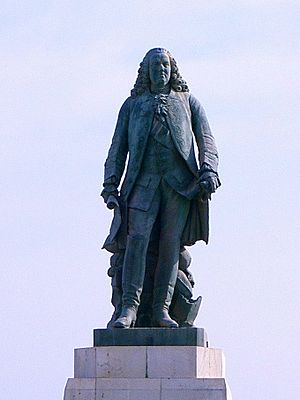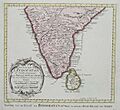French East India Company facts for kids

Company flag
|
|

|
|
|
Native name
|
Compagnie française pour le commerce des Indes orientales
|
|---|---|
| Public State-owned enterprise |
|
| Industry | Trade |
| Fate | Dissolved and activities absorbed by the French Crown in 1769; reconstituted 1785, bankrupt 1794 |
| Founded | 1 September 1664 |
| Founder | Jean-Baptiste Colbert |
| Headquarters | Lorient |
The French East India Company (French: Compagnie française pour le commerce des Indes orientales) was a large trading company. It was started in France on September 1, 1664. Its main purpose was to trade with countries in the Eastern Hemisphere. This included places like India and other parts of Asia.
The company was created to compete with the very successful English and Dutch trading companies. King Louis XIV and his minister, Jean-Baptiste Colbert, helped set it up. The company was formed by combining three older French trading groups. Its first leader was François de la Faye. He worked with experienced traders like François Caron and Marcara Avanchintz.
Contents
History of the Company
Early French Trading Efforts
Before the French East India Company, France had tried to trade with the East Indies. In 1604, King Henry IV of France allowed an earlier company to form. This company had a 15-year right to be the only French trader in the East Indies.
During the 1600s, France made several attempts to trade with Asia. They were inspired by the success of the Dutch East India Company. French ships sailed in the Persian Gulf, the Red Sea, and along the coast of India. However, these efforts were smaller than those of England and the Netherlands.
Starting the New Company
The new French East India Company began with a lot of money. King Louis XIV himself invested a large sum. Many important people in France also invested, wanting to support the King's plans.
The company was given a 50-year right to be the only French trader in the Indian Ocean and Pacific Ocean. This huge area stretched from Africa's Cape of Good Hope to the Strait of Magellan in South America. The King also gave the company control over the island of Madagascar. The company had more money and political support than any French trading group before it.
One of France's main goals was to create a big trading center in Madagascar. They wanted it to be as important as the Dutch colony of Batavia (in modern-day Indonesia).
Challenges and Changes
By the 1680s, the company faced financial problems. It had to let other merchants use its trading rights. The company struggled to make a profit for about 30 years.
In 1716, a Scottish banker named John Law came to the French court. France was in great debt after a long war. Law suggested creating a national bank and using paper money.
The company failed to build a successful colony in Madagascar. But it did set up important ports on the nearby islands of Bourbon and Île-de-France. Today, these are known as Réunion and Mauritius.
By 1719, the company had set up trading posts in India. However, it was almost out of money. That same year, the French East India Company merged with other French trading companies. They formed a new, larger company called the Compagnie Perpétuelle des Indes. This new company also became involved in transporting people to work in its colonies, especially in Louisiana, which relied on large farms.
The French economy faced difficulties in 1721. After this, the company began trading and settling in India again. It became independent once more in 1723.
Trading in India
The French arrived in India much later than the English, Portuguese, and Dutch. On September 4, 1666, the French received permission from the Mughal Emperor Aurangzeb to trade at the port of Surat.
By 1683, the French focused on Pondicherry, which became a key location. However, the company still often lacked enough money. By 1738, the company had many workers in its colonies, including in Isle de France. Some of these workers were brought from West Africa.
As the Mughal Empire weakened, the French decided to get involved in Indian politics. They made alliances with local rulers in southern India to protect their interests. From 1741, the French leader Joseph François Dupleix pursued an aggressive policy. He fought against both Indian rulers and the British. Eventually, the French were defeated by Robert Clive of the British.
Even after these defeats, several Indian trading ports stayed under French control until 1954. These included Pondichéry and Chandernagore.
Rivalry and End of the Company
France's main rival was Great Britain. Constant wars in Europe, like the War of the Austrian Succession and the Seven Years' War, affected their colonies. The British gained control over French territories in India during these wars.
With the Treaty of Paris in 1763, the territories were returned to France. However, the French East India Company could not recover financially. It was officially closed down in 1769. King Louis XV ordered the company to give all its properties and rights to the state. The King agreed to pay the company's debts.
The company was started again in 1785. It was given the sole right to trade with countries beyond the Cape of Good Hope for seven years. But the French Revolution began, and in 1790, the new French Assembly ended the company's special trading rights. They declared that trade would be "thrown open to all Frenchmen."
The company was not used to competition or official disapproval. It slowly declined and was finally closed for good in 1794.
Images for kids
Map gallery
Coins
-
French-issued "Gold Pagoda" for Southern India trade, cast in Pondichéry 1705–1780.
-
French-issued rupee in the name of Mohammed Shah (1719–1748) for Northern India trade, cast in Pondichéry.
See also

- British East India Company, founded in 1600
- Portuguese East India Company, founded 1628
- Carnatic Wars
- Chanda Sahib
- Dutch East India Company, founded in 1602
- Dutch West India Company, founded in 1621
- European chartered companies founded around the 17th century (in French)
- France-Asia relations
- French colonial empire
- French India
- List of trading companies
- Lorient
- Muzaffar Jang
- Salabat Jang
- Swedish East India Company, founded in 1731
- Whampoa anchorage








